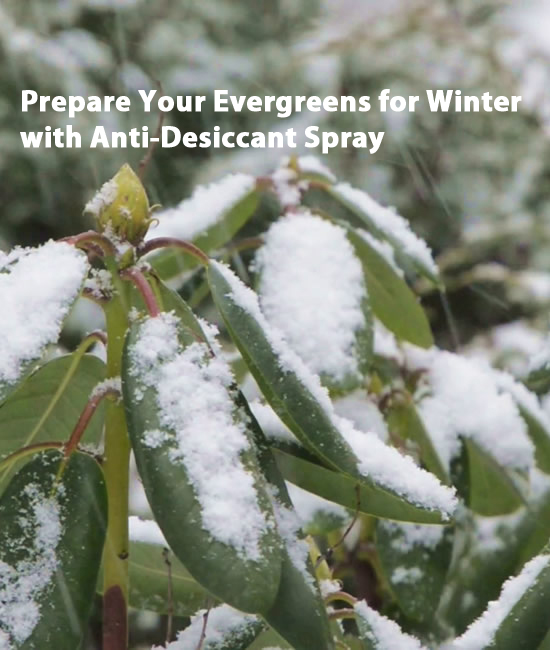
Congratulations, your yard is looking great! You’ve seeded and fertilized, but have you thought about the care needed for your evergreen trees and shrubs? Evergreens are hardy and often go unnoticed because of their durability, but they need protection from winter’s frigid temperatures too!
What is Winter Burn on Evergreens?
It might be to your dismay to find your evergreens with chunks of dead needles or leaves. Fluctuating winter temperatures and precipitation can wreak havoc on evergreen foliage.
Since evergreens (both needle & broadleaf varieties) maintain live foliage throughout the winter, they can lose moisture, even when frozen. Sunny, winter days are especially detrimental to evergreens. Exposure to harsh sunlight increases the rate of moisture loss and leads to winter burn on shrubs or evergreens.
If the moisture loss is too significant, the needles or leaves can dehydrate and die. Frozen ground can also cause issues, as the roots may not be able to deliver water to the plant as needed, also resulting in dying needles and leaves.
How to Prevent Winter Burn on Evergreens: 4 Ways to Stop Winter Burn
They are many methods to prevent winter burn on your evergreens. You can take a few preventative measures to stop your shrubs and evergreens from being blighted by winter.
1) Avoid placing shrubs or evergreens in areas that are hit directly by the sun or wind
Winter sun and wind are hard on evergreens. When planting evergreens, situate them in areas that are not in the direct path of harsh sunlight and wind.
2) Wrap plants in burlap
Burlap is another common and simple way to protect evergreen. Wrapping evergreens in burlap provides a physical barrier against wind and sun.
3) Water thoroughly in the fall
Keep watering evergreens throughout the fall until the ground freezes. Keeping evergreens hydrated helps protect them against winter injury.
4) Spray shrubs and evergreens with an anti-desiccant
Anti-desiccants coat the needles or foliage of evergreens allowing them to trap more moisture. The extra moisture will go a long way in preventing winter injury.
Anti-Desiccant Spray for Evergreens, Shrubs, and yes even the Christmas Tree
Anti-desiccant coats the leaves to help slow the process of transpiration, keeping moisture in, and your shrubs and trees healthy. Evergreens and shrubs like boxwood, rhododendron, arborvitae all need special care to prevent winter burn.
Spraying these shrubs with anti-desiccants could help retain moisture throughout the winter. Anti-desiccant spray is also ideal for keeping your Christmas tree green.
You can find anti-desiccant spray at your local garden center in a trigger sprayer or in the pure concentration. Concentrated anti-desiccant needs to be diluted. Follow the product instruction for dilution before applying to plants.
You’ll need a sprayer if you choose an anti-desiccant concentration. If you are a professional or you have a large area to cover, a pressure sprayer is an excellent option for treating evergreens.
How to Apply Anti-Desiccant Spray? A 4-Step Guide
If you decide to pursue the anti-desiccant path, you may be wondering how to apply an anti-desiccant spray. Most anti-desiccants come in a trigger sprayer for you to spray shrubs and evergreens. For anti-desiccants to be effective, a few conditions need to be in place.
1) Spray in late November or early December after evergreens have gone dormant.
2) Monitor the forecast for rain. You don’t want to spray anti-desiccants before it rains.
3) Spray on a clear day with temperatures above freezing, around the 40s or 50s.
4) Cover leaves thoroughly with the anti-desiccant spray.
Is it Necessary? Is it the Best Option?
Anti-desiccant spray isn’t strictly necessary. If you’re concerned about protecting your evergreens from the cold but don’t want to use a spray, wrap plants in burlap.
An article by the Chicago Tribune argues that anti-desiccants are unnecessary in most garden situations, and suggests that homeowners should place evergreens in areas where they are protected from the winter sun and wind. An anti-desiccant spray is one option of many to protect evergreens and shrubs.
Useful Resources
Check out these helpful articles on protecting your trees and shrubs with anti-desiccants.
How to Protect Trees and Shrubs from Cold Weather
Anti-desiccant spray is unnecessary in most garden situations
Protecting Evergreens in the Winter Q&A
This is an updated of a post from two years ago. Here is the original: https://us.solo.global/news/21_anti-desiccant-treatment.html

